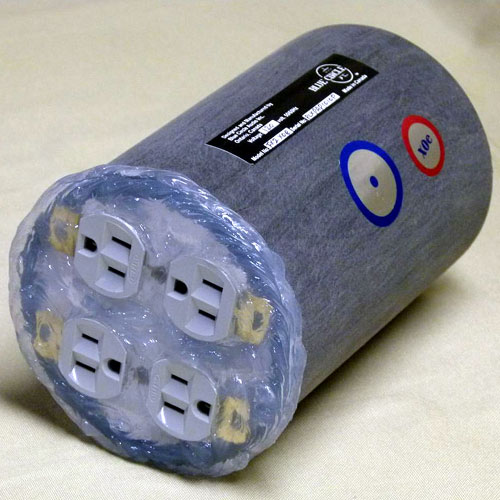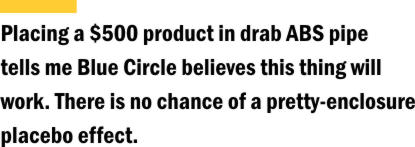Blue
Circle Audio • PLC Thingee FX2 with X0e Power Conditioner
A reasonably priced power-line conditioner from the fertile mind of Gilbert Yeung.
I don't think I'm alone. I imagine that for many music lovers power products are last on the list when it comes time to buy new equipment. I’ve gone out of my way to visit shops that have certain turntables I’m interested in or have big speakers that I wanted to hear, but I’ve never gone to check out a power conditioner. This results in a kind of purity for power products: They are purchased only if they make a sonic improvement. Aspects of user interface might make me favor one front-end product over another, and speaker size may influence my buying decision, but I’m going to buy a power conditioner only if I hear what it does. The six-outlet PLC Thingee FX2 with X0e module (hereafter, the Thingee FX2) is housed in a round ABS pipe that is 6 3/8" (162mm) long and 4 1/2" (114mm) in diameter. One end has four outlets; the other has two and a receptacle for the power cord. Holding everything in place is a huge amount of semi-clear silicone caulk. The Thingee FX2 shipped with a nondescript power cord, which I used for the entire review process. My wife thought the Thingee FX2 looked like something that might appear on the "What Is It?" segment of Ask This Old House. It looks somewhat familiar, but it's just slightly off enough to make you wonder if it is what you think it is. At first a round component didn’t strike me as practical, as it might easily roll around or right off a shelf, but it proved stable. It is heavier than it looks and once it is plugged into the wall and other products are plugged into it, there is no chance it will roll anywhere. The silicone seals leave no way to look at what’s going on inside the Thingee FX2, but Blue Circle states, "The outlets are all high-quality industrial-grade. All the internal wiring is double runs of 14AWG solid copper connecting the IEC power inlet, the filter networks, and the industrial outlets. Extremely short current paths, coupled with the double 14AWG wire, means that from a resistance perspective, these units are virtually invisible." The X0e filter is designed for low-frequency noise, which extends the frequency spectrum over which the unit operates. Blue Circle says that the development of the X0e filter is a direct result of "trickle-down technology"; it is based on the X1e filter designed for their BC60X1 balanced power conditioner ($4495).
I’ve been lazy when it comes to power-related products; there’s no good reason for this. Last year, however, I faced a practical problem. Occasionally the lights in my listening room would dim and my turntable would audibly slow down. It did not happen every day, but when it did happen it was at roughly the same time of day, so something was clearly going on with the power delivery where I live. This led me to a practical and inexpensive solution: an APC H15 power conditioner. It gives me peace of mind and seems effective in keeping everything running. I haven’t had the power problem since installing the APC, but I don’t know if this is coincident or causal. Certainly, it did no harm. It also did not provide much in terms of audible improvement. When I first received the Thingee FX2, I realized that I wasn’t in the mood to crawl behind my rack and start unplugging everything. I did want to make sure it was working on delivery, however, so I plugged my television into each of the six outlets. Unsurprisingly, all of the outlets worked; surprisingly, the Thingee FX2 seemed to improve the television's blacks -- black clothing in dark lighting seemed better defined and subtle dark patterns, like herringbone, were more sharply reproduced. The six outlets on the Thingee FX2 were just enough for me: integrated amplifier, disc player, phono stage, turntable, DAC and computer. I know some people believe in components needing time to break in, so I let the Thingee FX2 work in my system for weeks before any kind of serious evaluation. I’m generally skeptical about break-in. I have an easier time understanding the rationale for components with moving parts, because it seems possible that they need to settle or loosen up after manufacturing. I have a much harder time with the rationale for breaking in components with non-moving parts. There may be a good rationale -- I just haven’t been convinced yet. Even with a good rationale, though, I have an epistemic problem with break-in: Is the sound changing or, over time, am I just getting used to a new normal? I think that’s a significant question that requires empirical inquiry by cognitive psychologists. I’m just an armchair audio reviewer, so the best I can do is this: I used the Thingee FX2 for weeks without thinking about it. I listened to music, but I didn’t try to pick it apart immediately. After weeks of passive listening, I took up my reviewer’s pen and got to work. hen I started the evaluation process, I plugged everything but my integrated amp into the Thingee FX2. After some time listening, I also plugged my amp into it. I didn’t know if the power-hungry amp would impact the Thingee FX2’s performance with source components. It turned out that the addition of the amp did not worsen the performance, but actually improved it. So, for the remainder of the review period, I kept everything plugged into the Thingee FX2. It became the sole power product in the system, plugged straight into the wall with the supplied cord and everything else plugged into it. While the sonic improvement produced by the Thingee FX2 was of the same character across sources, it was more pronounced with digital, both from discs in my disc player and computer files from my computer through a DAC. The first noticeable improvement was in the spatial separation of instruments from each other and from voices. One of Johnny Cash’s final albums, American IV: The Man Comes Around [American/Legacy 8869783465], included a performance of "Danny Boy" featuring Cash’s distinctive vocals along with an organ. With the Thingee FX2, Cash’s voice seemed to float directly on top of the organ’s haunting notes, which made it seem as though there was more space between Cash and the organ, giving his voice more weight. On more musically complex tracks, like Stravinsky’s The Rite of Spring by Seiji Ozawa and the Chicago Symphony Orchestra [RCA Red Seal 09026-63311-2], there was a less pronounced improvement in instrumental separation, but a greater improvement in the depth of the soundstage, which seemed to deepen so that the aural space extended both farther forward and deeper than without the Thingee FX2. Music with strong bass presence, such as the doom metal of Electric Wizard’s Supercoven [Southern Lord Records SUNN 4] or the funk of J. Dilla’s The Shining [BBE Records BBECD 076], had noticeable increase in the definition of the bass lines. The low frequencies had more precision and clarity and less indistinct thump. What I mention above occurred with digital. The improvement with analog playback was evident, though not as pronounced; the music didn't display quite the same dynamic pop, which could be related to the format, not the Thingee FX2. Still, Weezer’s "The Good Life" from the Mobile Fidelity edition of Pinkerton [Geffen/Mobile Fidelity MFSL 1-393] offered more punch from the drums, while the guitars seemed slightly leaner and better defined. Similar improvements were heard on jazz records, like Miles Davis’s soundtrack for the film L’Ascenseur pour L’Echafaud from the recent mono edition of Jazz Track [Columbia CL1268]. The opening interplay between the bass and horn had similar, though less pronounced, spatial improvement as that of the Cash recording. The instruments were more defined and separated. Toward the end of the soundtrack there is a short passage with bass and percussion that showed the most improvement I heard with vinyl: the definition of bass instruments and presentation of percussive force were obviously better. The Thingee FX2 is not a portable product, but its size makes it easy enough to move around. When I finished my home evaluation I packed the Thingee FX2, my DAC and headphones into a tote bag and brought them to work. My workplace has incredibly poor power for audio. There are not only WiFi boosters, Ethernet wires and more computers than I can count, but research labs that have all manner of large- and small-scale machinery. Moreover, I have empirical evidence that the power is awful: Sometimes the powered speakers in my office buzz even when they aren’t on. When they are on there is sometimes audible noise (it almost sounds like Morse code at times). When I’m in my office I usually listen to Internet radio (lately I’ve been enjoying SomaFM’s Earwaves stream). The sonic presentation is fine for background listening, if you can ignore the buzzing and chatter that come through the speakers. The Thingee FX2 more than proved its worth in this environment. There was no buzzing through the speakers or headphones. When I listened through my headphones, the sound was enjoyable because of the much lower noise floor and the clear improvement in dynamics. eviews often end with the exhortation that readers should try before they buy; that’s always good advice, but it is imperative in this case. If my turntable in my home system was my only source, I’m not sure the improvement brought by the Thingee FX2 would be enough to make me want to purchase it. Add the improvement with digital sources, though, and it begins to have a very good cost-to-benefit ratio. The improvements I heard at my workplace would make it an easy purchase. How good a value the Thingee FX2 is, then, will vary
along three lines that are not easily generalized: location, application and value. My
experience did convince me that for some listeners the Thingee FX2 could not just enhance
their systems, but revitalize them.
|



 Gray ABS pipe isn
Gray ABS pipe isn